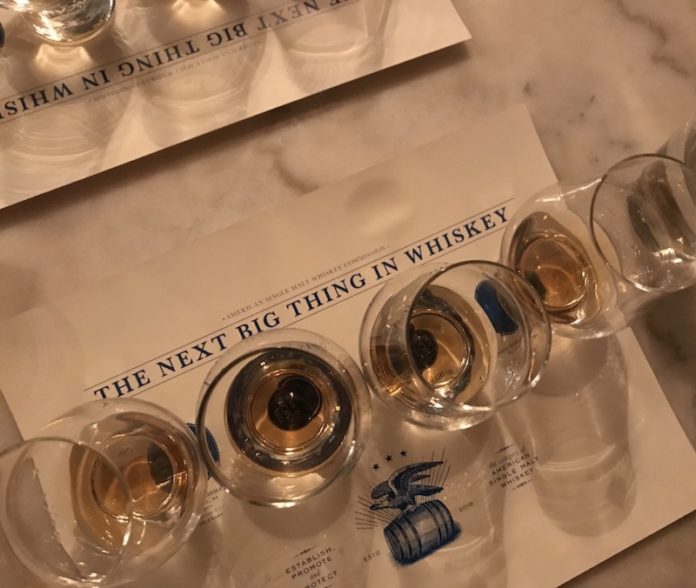U.S. distilleries produce an impressive diversity of American single malt whiskey, yet the question remains — do consumers understand the category?
This question was discussed during a panel hosted yesterday in Manhattan by the American Single Malt Whiskey Commission. On the panel sat several founding members of the commission — Steve Hawley and Chris Riesbeck of Westland Distillery, Gareth Moore of Virginia Distillery, Gabriel RiChard of Balcones Distilling and Randy Hudson of Triple Eight Distillery — plus whiskey/beer writer Lew Bryson
Founded in 2016, the commission now counts 150-plus members. Factor in non-members who are also distilling American single malt, and that’s a lot of producers making this style of whiskey. Yet there is no official, federally recognized definition for the category.
“Every other category of whiskey has a formal definition — from Irish to bourbon to Scotch — so we want one that has the mission of letting consumers know exactly what is in the bottle,” says Moore.
This is particularly important in a time when mainstream America still learning the nuances of whiskey. “We’re still trying to teach consumers that bourbon is whiskey, but not all whiskey is bourbon,” Riesbeck points out.
So what exactly is American single malt? The commission formed in part to establish a definition. By their rules, the style must be 100% malted barley, and distilled entirely at one distillery. Both guidelines should sound familiar, since they’re also standards for Scotch. But that’s where the similarities end.
The commission’s definition also mandates that American single malt be mashed, distilled and matured in the U.S. (Note that the grains themselves can come from foreign countries.) Producers must distill the spirit to no more than 160 proof, and bottle at a minimum of 80. Maturation takes place in oak casks not exceeding 700 liters.
The operative part in that last rule is the part that is missing. Unlike Scotch — which restricts barrel types — American single malt can age in any style of cask. Many producers including Westland, Virginia and Corsair have made ample use of this leeway, along with a broad range of smoke sources for the malt.
Which points to the larger theme of creativity that differentiates American single malt from the rest of the world.
“There’s fertile ground for new producers to come in and make new whiskeys that are worth consumers’ dollars,” says Riesbeck. “The intention of what we’re doing is not to make Scotch in America, but whiskey that’s indicative of who each of us [distilleries] are.”
While good in theory, the problem remains that your typical consumer does not understand this category. After reading “American Single Malt” on the label, many people will ask whether the product is Scotch. (Which it is not, of course, as Scotch cannot be made in America.) Complicating matters is the lack of a government-approved definition. American single malt occupies a nebulous space.
“You go into a lot of retail stores now, and American single malt is distributed throughout the shelves,” says Hawley. “There’s no specific American whiskey section like there is for Japanese, or Irish or even ‘World Whisky’. You’ll likely find the American single malt whiskeys in ‘American’ or ‘Craft’ or the dreaded ‘Other’. This commission came together to change that.”
Their work begins with The U.S. Alcohol and Tobacco Tax and Trade Bureau (TTB). In 2017, the commission formally submitted a petition to the TTB for a legally recognized definition. Response has been slow.
“We’re not here to bash the TTB,” says Hawley. “They have an enormous task on hand. I think they have only six or seven employees, who must approve every label submitted for every beer, whiskey and wine in America.”
By all accounts, everybody is onboard with the idea, Hawley adds, including the Scotch whisky industry. He remains hopeful that the government might take action in the next six-to-twelve months. One road block, though, is the 2020 presidential election. It’s unlikely the TTB updates its Beverage Alcohol Manual before then, as the bureau has not changed the “BAM” in three decades.
In the meantime, the category continues to produce a wide range of excellent whiskeys. It’s a bit of an awkward situation, where the quality of what’s in the bottle far exceeds the legislation behind it.
“In this country, American single malt technically does not exist,” says Hawley. “There are no rules governing what American single malt is. And to us, that’s a big problem.”
Kyle Swartz is editor of Beverage Dynamics magazine. Reach him at kswartz@epgmediallc.com or on Twitter @kswartzz. Read his recent piece Interview: Jim Murray on the Evolution of American Whiskey.






